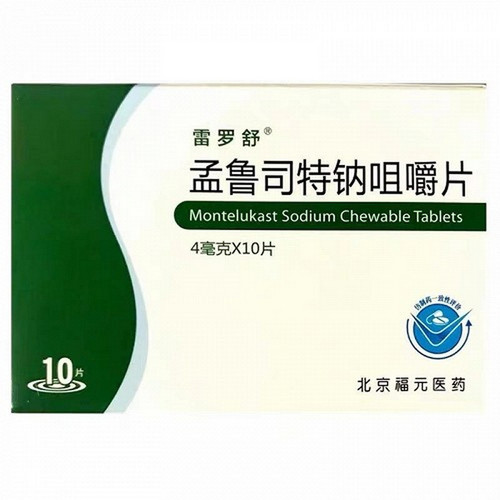Product Overview
[Drug Name]
Generic Name: Montelukast Sodium Chewable Tablets
Trade Name: Singulair Montelukast Sodium Chewable Tablets 4mg*5 Tablets
Pinyin Code: ShunErNing MengLuSiTeNaJuJiaoPian 4mg*5 Tablets
[Main Ingredients]
The main ingredient of this product is montelukast sodium.
[Appearance]
This product is a pink, oval tablet.
[Indications/Main Functions]
1. This product is indicated for the prevention and long-term treatment of asthma in children aged 2 to 14 years, including prevention of daytime and nighttime asthma symptoms, treatment of aspirin-sensitive asthma, and prevention of exercise-induced bronchoconstriction. 2. This product is indicated for the relief of symptoms caused by seasonal allergic rhinitis (for both seasonal and perennial allergic rhinitis in children aged 2 to 14 years).
[Specifications]
4mg*5 tablets (Singulair)
[Dosage and Administration]
Once daily. Asthma patients should take at bedtime. Patients with allergic rhinitis can take the medication as needed based on their individual needs. Patients with both asthma and seasonal allergic rhinitis should take the medication once nightly. Children aged 2 to 5 years with asthma and/or allergic rhinitis should take one tablet (4 mg) once daily. (See package insert for details.)
[Adverse Reactions]
This product is generally well tolerated, with mild adverse reactions that generally do not require discontinuation of treatment. The overall incidence of adverse reactions is similar to that of placebo. Postmarketing Experience: The following adverse reactions have been reported with this product since its marketing: Infections and infections: Upper respiratory tract infections. Blood and lymphatic system disorders: Increased bleeding tendency. Immune system disorders: Hypersensitivity reactions, including allergic reactions, and rare cases of hepatic eosinophilic infiltration. Psychiatric disorders: Excitement, including aggressive behavior or hostility, anxiety, depression, disorientation, abnormal dreams, hallucinations, insomnia, irritability, restlessness, sleepwalking, suicidal thoughts and behaviors (suicidal behavior), and tremors. Nervous System Disorders: Dizziness, somnolence, paresthesia/hyposthesia, and rarely, seizures. Cardiac Disorders: Palpitations. Respiratory, thoracic, and mediastinal system disorders, rhinitis. Gastrointestinal Disorders: Elevated ALT and AST, very rarely, hepatitis (including cholestatic, hepatocellular, and mixed forms). Skin and Subcutaneous Tissue Disorders: Angioedema, contusions, erythema nodosum, pruritus, rash, urticaria. Musculoskeletal and Connective Tissue Disorders: Arthralgia, myalgia including muscle cramps. Other Disorders and Administration Site Conditions: Asthenia/fatigue, edema, fever. (See package insert for details.)
[Contraindications]
This product is contraindicated in patients with hypersensitivity to any of the ingredients.
[Drug Interactions]
This product can be used in combination with other medications commonly used for the prevention and long-term treatment of asthma and the treatment of allergic rhinitis. In drug interaction studies, the recommended dose of this product did not produce clinically significant pharmacokinetic effects on the following drugs: theophylline, prednisone, prednisolone, oral contraceptives (ethinyl estradiol/norethindrone 35/1), terfenadine, digoxin, and warfarin. The area under the plasma concentration-time curve (AUC) of montelukast was reduced by approximately 40% in patients taking phenobarbital concomitantly. However, no dose adjustment of this product is recommended. In vitro studies have shown that montelukast is an inhibitor of CYP28. However, data from a clinical drug interaction study between montelukast and rosiglitazone (a typical probe substrate primarily metabolized by CYP28) showed that montelukast sodium did not inhibit CYP28 in vivo. Therefore, montelukast sodium is not expected to affect drugs metabolized by this enzyme (e.g., paclitaxel, rosiglitazone, repaglinide).
[Precautions]
The efficacy of this drug for the treatment of acute asthma attacks when taken orally has not been established. Therefore, it should not be used to treat acute asthma attacks. Although the dose of concomitant inhaled corticosteroids can be gradually reduced under the guidance of a physician, this drug should not be used to abruptly replace inhaled or oral corticosteroids. Psychoneural events have been reported in patients taking this drug (see Adverse Reactions). Because other factors may contribute to these events, a relationship to this drug cannot be confirmed. Physicians should discuss these adverse events with patients and/or caregivers. Patients and/or caregivers should be instructed to notify their physician if these events occur. (See package insert for details.)
[Pediatric Use]
Safety and efficacy studies have been conducted in children aged 6 months to 14 years. Safety and efficacy in children under 6 months of age have not been studied. Studies have shown that this drug does not affect growth rate in children.
[Elderly Use]
Not applicable.
[Overdose]
Specific data regarding overdose with this drug in clinical practice are not available. In studies for the treatment of chronic asthma, no clinically significant adverse events were reported in adults at doses up to 200 mg daily for 22 weeks and in short-term studies at doses up to 900 mg daily for approximately one week. There have been reports of acute overdose in children postmarketing and clinical studies with this product, including reports of doses up to 100 mg in both adults and children. Clinical and laboratory findings consistently demonstrate its safety in both adults and children. In the majority of overdose reports, no adverse events were reported. The most common adverse events were consistent with the safety profile and included abdominal pain, somnolence, thirst, headache, vomiting, and psychomotor hyperactivity.
[Pharmacology and Toxicology]
Cysteinyl leukotrienes (LTC4, LTD4, LTE4) are potent inflammatory mediators released by a variety of cells, including mast cells and eosinophils. These important pro-asthma mediators bind to cysteinyl leukotriene (CysLT) receptors. Cysteinyl leukotriene type 1 (CysLT1) receptors are distributed throughout the human airways (including airway smooth muscle cells and airway macrophages) and other proinflammatory cells (including eosinophils and certain bone marrow stem cells). CysLTs are implicated in the pathophysiology of asthma and allergic rhinitis. In asthma, leukotriene-mediated effects include a range of airway responses, such as bronchoconstriction, mucus secretion, increased vascular permeability, and eosinophil accumulation. In allergic rhinitis, CysLTs, which are associated with allergic rhinitis symptoms, are released from the nasal mucosa during both the immediate and delayed phases following allergen exposure. Intranasal CysLT stimulation increases nasal airway resistance and symptoms of nasal obstruction.








